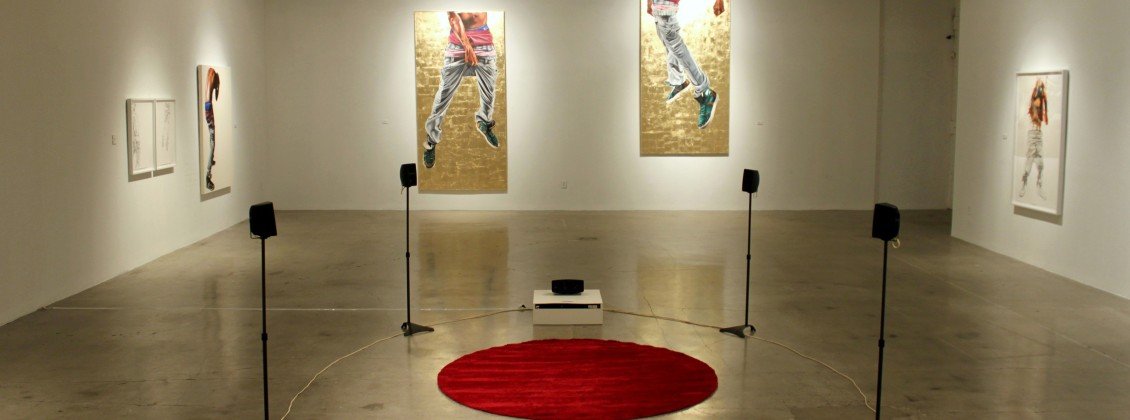
Installation View of GRAV-I-TY
Fahamu Pecou: GRAV·I·TY
2013/2014 Working Artist Project (WAP)
Exhibition Dates: December 13, 2014 – February 14, 2015
Opening Reception: Friday, December 12th / 6:30-8:30pm
Artist Talk: Tuesday, Januaty 27th / 6:30pm reception, 7pm talk
MOCA GA 2013/2014 Working Artist Project selected by Franklin Sirmans, Terri and Michael Smooke Department Head and Curator of Contemporary Art, Los Angeles County Museum of Art, Los Angeles.
“What struck me was that in a field of almost 100 applications there was not only a real depth of quality but that there were a group of artists whose practice demanded attention in this format. This is not an emerging artist prize. There were a number of artists I could have chosen if it were. Some of them are on view in the High Museum of Art’s fantastic show of works on paper that is up now. My charge was to think about ‘established visual artists to support as fellows as of the ongoing Working Artist Project (WAP). With that in mind, the WAP fellows reflect the overall diversity of the applications in terms of media, construction and style. Like the best artists over time, each one is deeply, deeply invested and committed to their projects. They have each been practicing and honing their style for a while so that it is now a pliable language for them to move forward in an expansive way.
“…Fahamu Pecou is squarely in the ever-increasing database world of digital images. Though he is using the old mode of oil on canvas painting, he does so with the structure of other media, including the moving images of film and video, in addition to photography.”
– Franklin Sirmans
Click here to see more work by Fahamu Pecou in the MOCA GA Permanent Collection.
About Fahamu Pecou
Fahamu Pecou (b. 1975 in Brooklyn, New York) is an artist/scholar based in Atlanta, Georgia whose works comment on contemporary and hip-hop culture while simultaneously subverting it to include his ideas on fine art. Pecou’s paintings, performance art, and scholarly work addresses concerns around representations of black masculinity in popular culture and how these images impact both the reading and performance of black male masculinity and identity. Pecou’s work has been exhibited throughout the U.S. and abroad and is featured in several private and public collections which include the Nasher Museum of Art (Duke University), The High Museum of Art, and Clark Atlanta University Art Galleries in Atlanta, GA. Additionally his work has been featured in several texts including; DEFINITION: The Art and Design of Hip Hop, an anthology chronicling the impact of hip-hop on visual culture, written by famed graffiti artist and designer Cey Adams, 5 Cities/41 Artists: Artadia O8/09 (Published by ARTADIA, 2011), NOPLACENESS: Art in a Post-Urban Landscape (Published by Possible Futures, 2011) and In the Eye of the Muses: Selections from the Clark Atlanta University Art Collection (Clark Atlanta University, 2012). Currently he is a Ph.D. student in Emory University’s Institute of Liberal Arts (ILA). Pecou maintains an active exhibition schedule as well as public lectures and speaking engagements at colleges and museums nationwide.
ABOUT GRAV·I·TY
In his first solo museum exhibition, Fahamu Pecou uses the trend of “saggin” (the style which sees young men wearing pants well below their waist) as an allegory to talk about Black male mobility and agency.
The term gravity is used as a double entendre. It refers to both the physical concept of gravity – as in the force that presses matter towards the Earth – as well as the notion of something being grave and serious.
Considering saggin as a politicized fashion statement, Pecou asserts that the trend actually confronts hegemonic readings of acceptability and decency, readings he suggests often alienate and overlook Blackness. By conforming to prevailing ideas of respectability young African American men find their realities, sensibilities, and self-expression diminished, effectively rendering them invisible. Saggin then is an act of resistance and a demand to be seen.
But saggin is linked to many negative stereotypes making it both metaphorically and physically restrictive. The resulting irony is that in seeking autonomy, wearers of this trend mark themselves with the weight and burden of those stereotypes.
“Grav•i•ty” troubles dominant ideologies around Black masculinity, especially as these ideas often use a vocabulary that images Black manhood in despair and disrepair. As a society, we often give up on Black boys before we’ve ever give them a chance. We meet them with fear and loathing. We limit their potential with tragic statistics about their potential and stories of their impending death. The resulting anxieties tether Black boys – and men – to the weight of their disposition, rendering them ultimately, immobile.
But what if we resisted this idea of gravity? What if we believed in Black boys instead of belittling them? Could they… Would they fly? Could we defy gravity and it’s limitations?